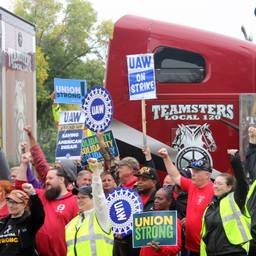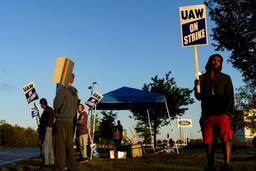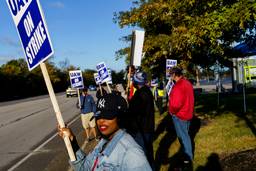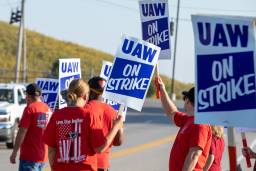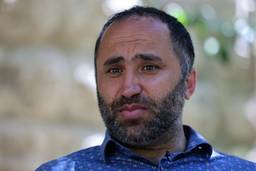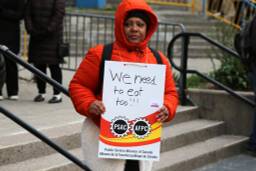The UAW Fight is an Exercise in Class Struggle Unionism
UAW President Shawn Fain has said that “corporate greed” is the enemy, and autoworkers are fighting back.
Teddy Ostrow and Ruby Walsh
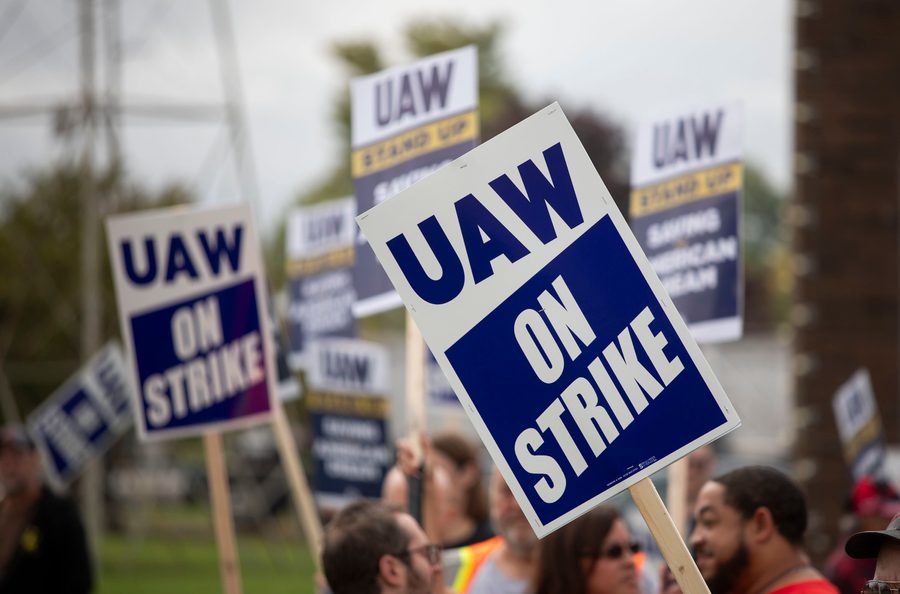
Read the full transcript below.
In this episode, we bring you to the UAW picket lines and rallies across three states — Michigan, Ohio and New York. You’ll hear the perspectives and stories of over a dozen rank-and-file autoworkers, as well as direct interviews with UAW President Shawn Fain and other union leaders.
This transcript has been edited for length and clarity. This episode and transcript were released on September 29th. For updates about the UAW, visit www.inthesetimes.com.
Walter Robinson Jr: You shouldn’t have to struggle when you work for one of the Big 3. Because you come in at $16.67. That’s not a livable wage anywhere in the United States.
Perry Wilks Jr: Medical costs is up, outrageous food costs, housing, rent
Valelynn Marshall: We’ve been losing every contract. We always got pushed back to give to the next man.
Valelynn Marshall: Like this is history to me. It’s been long overdue. I’m confident that we will come out better this time around. Because we showing them that we mean it.
Teddy Ostrow: Hello my name is Teddy Ostrow. Welcome to The Upsurge, a podcast about the future of the American labor movement.
This podcast covers the renewed militancy of the United Auto Workers, the legendary union that right now, for the first time in its history, is striking each of the Big 3 automakers at once. That’s Ford, General Motors, and Stellantis, the owner of Chrysler, Jeep and other brands.
The Upsurge is produced in partnership with In These Times and The Real News Network. Both are nonprofit media organizations that cover the labor movement closely. Check them out at inthesetimes.com and therealnews.com where you can also find an archive of all our past episodes.
And a quick reminder: This is a listener-supported podcast. So please, if you want it to keep going, head on over to patreon.com/upsurgepod and become a monthly contributor today. You can find a link in the description.
And as an extra incentive, the next 18 people who sign up for our Patreon will receive a free one-year subscription to In These Times magazine, one of the best outlets covering the labor movement and progressive politics today.
On to the show.
In this episode, we’re bringing you on the ground of the UAW Stand Up pickets lines, where, as of this recording, over 18,000 Big 3 autoworkers across twenty states are out on strike. By the time this episode posts, however, there may thousands more on the line. Maybe even all 146,000 autoworkers across the three companies.
But we’re gonna begin this story on the night of September 14, when the strike clock was still ticking.
I’m at UAW Local 900, which is the Local of the Ford Michigan Assembly Plant here in Wayne, Michigan. And we are about an hour away from the strike deadline
That’s me, talking to myself in the corner of a relatively quiet UAW union hall.
Sean Fain just went on Facebook Live and announced that the Michigan Assembly Plant was one of the three locations that will be struck if the companies and The UAW don’t come to a deal.
I watched as UAW members emptied snacks and drinks onto tables, and stacked picket signs near the entrance of the hall.
In an hour’s time, the room would be abuzz with workers who had laid down their tools at the auto plant across the street. Thousands of others would do the same at assembly plants in Ohio and Missouri. And in a week’s time, 5,000 more workers in parts depots across the country would walk out, too.
Here in Michigan, they would soon line up in the union hall to receive their picketing assignments, and then join the crowd that had already started assembling outside the plant’s main gate.
After midnight, the picket lines were up.
Brandi White: I am happy. We ain’t playing no games. I am happy. Okay, it’s my first strike, and like, as long as I’ve been here, and I’m out here.
Robert Harrison: I’m, you know, fighting for my union. I think this is a perfect opportunity.
It just feels good to see everybody outside to come together. You know, we come as a unit.
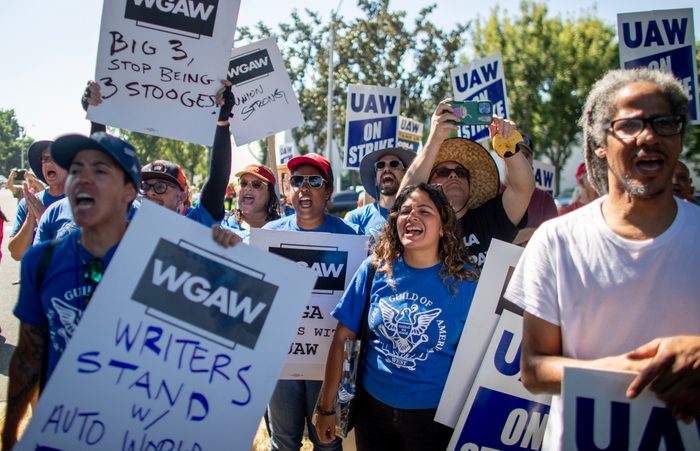
Darnell Foreman: We just got off. So we’re here supporting all our union brothers and sisters, you know, supporting everyone.
Teddy Ostrow: It was a boisterous first night in Wayne Michigan, but when I drove fifty miles south to the Jeep assembly plant in Toledo, Ohio, the next day, I got to hear about what it was like for the Stellantis workers who also walked off the job. Here’s Melanie Smith on the picket line:
Melanie Smith: My mom, works second shift in a body shop, and I was at home when the strike happened, but she was at work on the phone, and they were going wild.
So excited to finally strike for our rights.
Teddy Ostrow: Melanie could hear the jubilant scene behind her mother’s voice.
Melanie Smith: When it got announced on Facebook, everybody just starts screaming like we’re about to go home early, you know? It’s hype.
Teddy Ostrow: On that first night, it was official. 13,000 UAW members had walked off the job. And it is the first time in the union’s history that they are striking each of the Big 3 simultaneously. Normally the union had picked one company as a target. Once they negotiated a contract with them, it would set the pattern for the rest. Not this time.
Over the course of the first week, I asked workers across picket lines why they were striking.
Shaun Gaddis: We’re out here to fight for our wages. We’re out here to fight for our pensions, and we’re out here to end tiers.
Anita Hill: I’m out here for everything. Equal pay, no tiers, of course the money.
Brandi White: I want to see COLA because every year it’s going up and we’re not going nowhere. I want health care when I retire.
Teddy Ostrow: Other demands by the union include a 32-hour work week, the right to strike over plant closures, which are a dark cloud over autoworkers’ job security, and the end to the companies’ abuse of temporary workers.
Ultimately, what it comes down to is that autoworkers are fed up with decades of backsliding, concessionary contracts.
Samantha Parker: We’re out here because we want a fair contract and to get stuff back that we gave up when we helped bail out the automotive industry.
Teddy Ostrow: You see, they don’t want to give anymore, like they did during the Great Recession to save Chrysler and GM as they went bankrupt. No, they work for companies now that made a combined 21 billion dollars in profits in just the first six months of this year. A quarter-trillion across North America in the past decade. Meanwhile, the average hourly wages of assembly line autoworkers have declined by 30% since 2003. UAW members are saying enough is enough. We’re not going to give anymore. We’re going to take.
Shaun Gaddis: The CEOs, they got 46% pay raises. The shareholders got a 150% pay raise, but the workers get nothing and we’re the backbone of the company. We didn’t know our plant was going to strike, but… We’re here for the fight. We’re going to stand in solidarity to get what we deserve.
Teddy Ostrow: Now, who the union is striking is not the only historic element of this fight, but also how they’re striking. Given the union’s bargaining failures of years past, the UAW has scrapped its old playbook and developed a new strategy, called the “Stand Up” strike. That’s a call-back of sorts to the GM Flint sit-downs of 1936-37 that helped build the union.
Rather than striking all company facilities at once, they are targeting specific plants at each of the Big 3, asking them to stand up and join the picket line in waves. It gives the UAW the leverage of potentially calling out more facilities should the companies not play ball. If the Big 3 stonewall the union, the strike will grow over time.
The purpose is to keep the companies guessing; to play the Big 3 off one another in negotiations, rewarding the corporations that make concessions, while inflicting more financial pain on those that remain stubborn. Some have compared it to a game of chess.
While some workers I spoke with were anxious to just join the strike already, most UAW members told me they were on board with the strategy. Here’s Sean Crawford, a GM worker at the Warren Tech Center with UAW Local 160.
Sean Crawford: I think it’s a new, exciting and creative strategy, and I want to see it work. I think it’s… more likely to work because we’re going to be able to stretch out the strike and defense fund.
Teddy Ostrow: That’s another advantage. The union’s $825 million dollar strike fund is no small sum, but with the stand up strategy, the union won’t risk blowing through it. Most workers can stay on the job, and if they’re laid off by the company, some will be able to draw from unemployment insurance.
Over the week I spent in Metro Detroit, I zig-zagged across Michigian and Ohio, attending picket lines, rallies, and other actions. You can hear the honks of solidarity by passersby that were a near constant backdrop to my conversations.
On that first night in Wayne, Michigan I met Walter Robinson Jr, a UAW quality rep at the Ford plant. With over three decades on the job, Walter explained that he actually wasn’t on the line for workers like himself. Rather, he was standing in solidarity for future generations.
Teddy Ostrow: So, what are we doing out here? What are you doing and how are you feeling?
Walter Robinson Jr: Well, we’re out here. We’re feeling good. The thing is that we’re here to make sure that the future people that get hired in…I’ve got 34 years. It’s people out here that’s struggling, that work in this plant every day and they shouldn’t have to. You shouldn’t have to struggle when you work for one of the Big 3.
Teddy Ostrow: You see, Walter makes top rate at around $32 per hour. But because of concessions in previous contracts, many workers hired after him may start at under half of his wages. Sometimes under $16 per hour. And it can take them eight years to catch up.
Walter Robinson Jr: We need to make sure that we get more pay for our entry level people because you come in at $16.67. That’s not a livable wage anywhere in the United States. So these people that come in here and work every day can’t even buy the product that we’re building — the trucks that we’re building cost between $60,000 and $90,000.
Teddy Ostrow: I heard this a lot. That workers can’t afford to buy the cars they themselves are building. But pay is not the only thing that separates Walter from many of his coworkers.
Walter also has a pension, and he has good retiree medical benefits funded by the employer. Despite doing the same work as Walter, most of his coworkers do not have such privileges.
We’re talking about something we’ve covered on The Upsurge before. A cancer for unions. We’re talking about tiers. GM, Ford, and Stellantis - they’re riddled with the things. And the UAW wants to end them once and for all.
Tiffiny Shipp: It’s electricity in the air!
Teddy Ostrow: That is Tiffiny Shipp, a Ford worker. With the energy she brings, you may be surprised to hear that she is actually not on strike. Not yet at least.
Teddy Ostrow: Tiffiny works in the body shop of the Ford Dearborn Truck Plant. She’s been there for ten years, which means she was hired after 2007. And that means that she’s a tier two worker.
Teddy Ostrow: Tell me about the tiers. What do you think about it? What needs to be done?
Tiffiny Shipp: They need to end them. I remember starting, and I’ll never forget my first day. This girl told me, “You know what, I wouldn’t be here for half pay.” I said, “What do you mean?” I didn’t even know how much the pay was here. I thought I was getting paid what everybody else was. And she’s like, “No, I get paid 30 an hour.” I’m like, “What?”
I almost choked. She’s like, “Yeah, you only get $15.66.” And just the fact that someone can stand next to you and brag about their house or their car, and you’re struggling!
That’s a shame. That’s not right.
Teddy Ostrow: Tiffiany explained that the problem is not just lower starting pay, or the retirement benefits tier two workers don’t get. It’s also what tiers do to worker solidarity.
Tiffiny Shipp: And the point is, it separates, divides. It adds animosity. You know, it just does. It creates really a hostile work environment.
Teddy Ostrow: Thankfully, that animosity didn’t seem to break bonds of solidarity on the picket lines.
Now, the thing about tiers at the Big 3 is there’s a lot of them, and beginning with the 2007 contract, it was just tier, after tier, after tier.
In Toledo, I met a number of workers who are even further down the totem pole than Tiffiny is.
Devin Dominique: I am a production line operator. I’ve been a SE, which is a supplemental employee since 2018,
Teddy Ostrow: Devin is actually the first person I spoke to on the picket line at the Toledo Jeep plant. He’s a supplemental employee, which is just another title for part-time temporary worker, or “temp” for short.
He does regular assembly line work, but with even lower pay than tier two workers, and much worse health care benefits. This is why temps are often referred to by UAW members as tier three workers.
But the biggest problem for temps, especially at Stellantis, is they’re not all that temporary.
Devin Dominique: So I believe that’s a little bit of some BS.
Out here being part time, not by choice, for five to six years.
Teddy Ostrow: You heard that right. Devin’s been a temp for nearly six years. This is personal for him. His grandparents worked and retired at the same Jeep plant. He wants the same thing. He wants to be made permanent. But there really isn’t a clear pathway in the contract for that to happen.
Devin Dominique: I believe that every SE feels the same way as me. I think they all want to be hired in. I think that it’s a reasonable thing. I don’t think it’s too much to ask. I don’t think too many people want to be part time for five, six years, you know, and then with no opportunity or no assurance that we’ll even get hired in, so I don’t think this strike is for nothing.
Teddy Ostrow: Do you work part time hours?
Devin Dominique: No, I work 60 hours a week.
You know, some weeks they might call a day off or something like that, but I work 6 days a week, if I can.
Teddy Ostrow: The union is calling for the Big 3 to hire temps after 90-days of work. Temps like Devin are among the most precarious workers in the Big 3 workforce. Which means striking can be especially difficult as they subsist on just $500 weekly strike pay.
Teddy Ostrow: How did you feel when you heard you guys were going on strike?
Devin Dominique: My girlfriend actually started crying because she’s worried about our bills being paid. But I told her that this is actually the first kind of sign of relief that I’ve had in this company in a long time. Because I know that this is actually one of the only ways that we’ll probably get some of what we want or need.
Teddy Ostrow: Devin’s point really stuck with me. And he wasn’t the only one to make it. The truth is, striking isn’t easy. It can be tough financially, emotionally draining. But every single worker I spoke to said that they believe this is the only way they’ll get what they deserve. That by standing in solidarity with their coworkers, they can endure, and they can win.
Tiers are central to this year’s contract fight, but workers were also talking about issues that cut across classifications. Here’s Perry Wilks Jr. from the Ford Dearborn Truck Plant.
Perry Wilks Jr: Everything is skyrocketing and we need wages that’s going to benefit our lifestyle, our lives, [our] spirit.
Perry Wilks Jr: Medical costs is up, outrageous food costs, housing, rent.
Teddy Ostrow: One of the solutions, according to Perry and others I spoke to across Michigan and Ohio, is COLA, or cost-of-living adjustments. Those were the inflation-tacked raises that autoworkers have received since the Treaty of Detroit in 1950. During the bailouts, the union gave them up to help save GM and Chrysler. Now, the workers want them back.
But there was another thing workers talked about on the picket line, that was a little more… visible.
I can’t help but notice You have two risk guards.
Is that from working?
Perry Wilks Jr: Yes, it is. Some of these jobs are overloaded, they do not want to listen to the workers when they’re actually out here doing the physical work. They are creating issues, medical issues, like myself, which I have two carpal tunnel issues now that just happened this week in this plant on a job that’s overloaded.
Teddy Ostrow: By overloaded, Perry means that it’s basically impossible to perform the tasks that are asked of him in the time allotted. Without hurting yourself at least. Autoworkers are notoriously expected to perform fast, repetitive motions on the assembly line. Think of Charlie Chaplin in “Modern Times” - management speeds up the line so fast Chaplin has to hoist himself onto the belts just to keep up.
Here’s Melanie Smith and Johnny Reese at Jeep.
Melanie Smith: Over 200 cars per shift.
Johnny Reese: That’s just us. And then you think about next door, they’re building what, like 500?
Melanie Smith: Yeah.
Johnny Reese: Next door, building like 500 cars a day, 10 hour days.
Teddy Ostrow: Have you gotten injured? Have you suffered from anything?
Johnny Reese: I mean, back problems.
Melanie Smith: Yeah. And like your hands will be stiff and things.
Johnny Reese: Body hurt. You working 10 days on Sunday. All you want to do is relax. Your body beat up.
Teddy Ostrow: For some workers, like Samantha Parker, who has worked ten years on the assembly line at Stellantis, it’s a bit worse than just back problems or stiffness.
Samantha Parker: I have bilateral carpal tunnel.
Samantha Parker: I just had surgery on one hand and I have to have surgery on my other hand. It hurts to hold my child, my two year old. Like it shouldn’t hurt my body to hold my two year old because I’m sacrificing so much of my body and my life for this place.
Teddy Ostrow: And you don’t get a pension, right?
Samantha Parker: Nope.
Teddy Ostrow: Retiree medical benefits?
Samantha Parker: Nope, nothing like that.
Teddy Ostrow: I mean, how does it feel to do a really tough job, you have to have surgery for it, and then, when you retire, you don’t get these things.
Samantha Parker: It’s petrifying, because if my body’s already wearing down now, what’s it gonna be like after I’ve been here for 20, 30 years, and I don’t have anything to help keep my body going so I can hold my grandkids and then my great grandkids, God willing?
Teddy Ostrow: This is why one of the union’s demands is a 32 hour work week. More time off means workers can rest their bodies, and also, spend more time with their families. UAW members want to work to live, not live to work.
Teddy Ostrow: On top of all of this, these auto jobs that the UAW is fighting so hard to improve are more and more feeling like a gamble. Just a few feet from Samantha in Toledo, I spoke with Krystal Maggio.
Krystal Maggio: Yeah, I’ve been pushed around from plant closures. I’m originally from Belvedere Local 1268, and I came to Toledo Jeep a year and a half ago.
Teddy Ostrow: Belvidere, as in Belvidere, Illinois. You may have heard that name before. And that’s because it is one of the 65 communities decimated by a Big 3 plant closure over the past 20 years. Last year, Stellantis decided to shutter the Jeep plant in Belvidere where Krystal worked, laying off 1,300 workers.
Krystal was actually a part of an earlier round of layoffs there, but in order to keep her job, her wages, her benefits, she was forced to transfer to Toledo -- 300 miles from her entire family.
Krystal Maggio: . I don’t want to have to transfer again, but they say they wanted to close 18 more plants. That’s kind of scary.
Teddy Ostrow: Are you afraid it’s going to happen again?
Krystal Maggio: I mean, yeah, you never really know what could happen.
Teddy Ostrow: Over the years, thousands of autoworkers like Krystal have had to part with their communities or risk financial ruin, as the economy surrounding the plants dries up. Some workers have had to move 5, 6, 7 times. As Krystal noted, in negotiations with the UAW Stellantis is threatening to close 18 more plants around the country.
The union wants the right to strike the company over such plant closures, and for the Big 3 to set up programs to support workers left behind in the communities where they close up shop.
Now, it’s important to understand that there’s an international angle to this. Stellantis moved Belvidere’s production to Toluca, Mexico, where they can pay workers as low $2.50 per hour. This is a decades-long trend: automakers moving production to places where they can exploit workers more, and fatten their profits. That also includes moving production to US states in the south, where union density is lower and the laws are more hostile to workers.
That brings us to one of the most important aspects of the autoworkers’ fight.
What are the stakes of this fight for the auto industry, the EV transition, and the broader working class?
Shawn Fain: Well, the shameful part of the EV transition is our tax dollars are financing it, and the companies are taking all the money like always, and not even taking labor in the equation. Like always, corporations and billionaires get all the money, and working class people are left behind. It’s gotta stop.
Teddy Ostrow: That was Shawn Fain, the UAW president, on the first night of the strike at the Michigan Assembly.
What he’s explaining to me is that the emergent electric vehicle and battery industries, despite receiving hundreds of billions of dollars in federal loans, grants, and tax incentives, are trying to move full-steam ahead without union labor.
Indeed, most of the current or proposed EV plants in the United States are in the south, and will be run without UAW representation. So, part of why the right to strike over plant closures is so important, is because it’s one lever for the union to prevent the Big 3 from moving their plants to where the EV transition would erode union standards.
And more broadly, if the UAW wins a good contract out of this strike, it will position them to actually unionize this emergent, mostly non-union industry.
This willingness to take on corporate power… it’s something we haven’t seen from the UAW in a long time. I asked workers what they thought of this marked shift in their union.
Perry Wilks Jr: It’s been a long overdue. I take my hat off to president Shawn Fain.
David Carey Mack: I love the direction the union’s going in. That’s my guy. I love Shawn Fain. Everything that I want. Seeing him wrapped up in a box.
Valeynn Marshall: We needed a voice. The other ones was no good for us. That’s why we’re here right now. He really did it. He made it happen. And I’m happy about it.
Valelynn Marshall: Like this is history to me
Teddy Ostrow: Since the 1980s the UAW approach to unionism was one of so-called labor-management partnership. The union and employers working together to flourish in a competitive market.
But the reality of what that’s looked like for workers is concession after concession after concession. And eventually outright corruption.
But the new union leadership, led by Shawn Fain, an electrician at Chrysler from Kokomo, Indiana, is flipping the script.
Shawn Fain: You guys are ready to rumble now, aren’t you? We’re in it, baby.
Teddy Ostrow: Fain doesn’t shy away from confrontation. And he always keeps his eyes and words on what’s important for the workers.
Reporter: You’ve got competitors for these Big 3 automakers paying a lot less in some cases for labor than these companies. How can you expect… to actually get everything you’re asking?
Shawn Fain: Shame on those competitors. Number one. All this is the companies are trying to drive a race to the bottom, and we’re better than that.
America’s better than that.
Teddy Ostrow: And if you haven’t noticed, Fain speaking in terms we mostly don’t hear from modern labor leaders. He’s talking about a class struggle.
Shawn Fain: You know, we’ve been accused of causing a class war. Class war has been going on for 40 years in this country. The billionaire class has been taking everything, and the working class has been left scraping, paycheck to paycheck, just trying to survive. It’s time to put an end to that class war.
And it’s time to pick a side. Either you’re with the billionaire class, or you’re with the working class.
Teddy Ostrow: Now, while the mainstream media have focused mostly on Fain, who shocked the nation when he won the UAW presidency earlier this year, the real story sits squarely with the workers themselves.
Eric Truss: So what’s different about this time is, the members had a chance to get engaged in what’s called, one member, one vote, where they were able to do a direct election of their own president and executive board staff.
Teddy Ostrow: That’s Eric Truss, a Ford worker at the Dearborn Truck Plant and the financial secretary of Unite All Workers for Democracy, or UAWD, a rank-and-file reform caucus within the union.
Eric is explaining that prior to last year, rank and file workers couldn’t actually vote in an election for the union’s top officers. It was done through an undemocratic delegate system. But UAWD organized hard to introduce a one member, one vote system within the union. They then ran a slate of candidates, including Fain, a member of UAWD himself, all of whom won their seats.
Eric Truss:The members had a chance to do that and they took advantage of it and because they did and they got to experience Shawn being in office. They got to see a new approach towards how we negotiate and this has brought more fire to the membership than they’ve never seen.
Teddy Ostrow: The member-elected leadership appears to now be working actually on behalf of the members. And they’re being transparent about what’s going on in bargaining.
Eric Truss: It seems like under the old regime I’ll call it, that they’ve never been involved with the with the membership as much as Shawn. Shawn’s on Facebook. He even talked to the members on Facebook and addressed their questions, whereas the other caucus or the other administration, they would never tell what’s on the table.
They would just bring those contracts and say, this is the best we can do. Whereas Shawn says, this is where we’re at. What do you think about this?
Teddy Ostrow: The result has been a membership more activated than many workers have ever seen before. Autoworkers around the country participated in a first-ever contract campaign at the Big 3, organizing rallies, practice pickets, and other actions. With and without their local leadership’s support.
Even the workers who aren’t technically on strike yet, are standing up and doing what they can to keep the pressure on the Big 3. This includes not working voluntary overtime, as well as solidarity actions, such as member-led caravans circling the striking plants.
In Toledo, I stood with the strikers and watched as dozens of Jeeps, Chryslers and GM vehicles arrived in a convoy.
Beth Walls: It was awesome. Support from GM, their Local 14 was out here. Just hyping up everybody and showing their support. It was awesome. We’re all one big family. We’ll do what we have to do for one another.
Teddy Ostrow: In downtown Detroit, on the first day of the strike, I drove to a UAW rally with Senator Bernie Sanders, Representative Rashida Tlaib, Michigan Governor Gretchen Whitmer and other politicians. The event was a sea of red-shirted UAW members, chanting, dancing, and making their worker power known. Here’s Sean Crawford again of Local 160.
Sean Crawford: I feel inspired, feel hopeful. I think the whole event seemed poetic. You know, it’s a beautiful day here in Detroit. You know, the sky is blue. There’s a ton of folks out. More people than I’ve ever seen at a rally here before.
Teddy Ostrow: After the rally’s speeches, the crowd marched on Jefferson Avenue. As we made our way to the GM headquarters at the Renaissance Center, I ran into Ryder Littlejohn, a skilled trades Ford worker at the Stamping plant In Buffalo, New York. We’d spoken previously by phone. I asked him:
Have you ever seen unity like this in your union?
Ryder Littlejohn: Not in a long, long time. This is what the UAW has always been about. We’ve always been a progressive, organized union fighting for the working class. And it’s good to see it come back
Teddy Ostrow: Off the recording, as we crowded onto the steps of the GM HQ, workers chants grew louder. Ryder turned to me, shook his head in disbelief, and said, “Solidarity. Isn’t it beautiful?”
When I got home to Brooklyn a week into the strike, I have to admit I was a little sad to leave the picket line. The energy was infectious. The solidarity, beautiful, as Ryder put it.
But only a few days later, on September 22, I got my chance to join the strike again.
All right, so here’s the deal. 38 PDC, that’s Parts Distribution Centers, just went up across the nation from GM and Stellantis. It was just announced at 10 a. m. The UAW, Shawn Fain, through a Facebook livestream said, look Ford. We’re making progress there. We’re not going to strike any more plants, but GM and Stellantis, they’re not getting with the program.
So now I’m heading to the location at Tappan, New York, PDC, and yeah, we’re going to go find out what’s going on on the strike line in the second round of the UAW standup strikes.
I pulled up to Chrysler the picket line at 1 pm, an hour after roughly 80 workers walked off the job. As I said, Tappan wasn’t the only plant called to “stand up” on September 22. 5,000 other workers across the country - in California, Wisconsin, Georgia, and so on - also hit the picket line.
Tappan, where we stood, is in the New York metro area, so as you may expect, cost of living is incredibly high. It was no wonder that wage increases were at the top of the strikers’ demands.
I spoke to Celeste Miller, shop chair of UAW Local 3039, and Jeffrey Purcell, the Local’s president, who still drives the forklift at the plant.
Celeste Miller: When I started 30 years ago… I started at $15.74, now when you start, you start at $15.78, that’s 30 years later, that’s ridiculous.
Jeffrey Purcell: I’m a single father of three, so my family is on the line with this as well. Majority of people who work here commute about 45 minutes to an hour from here.
I personally live in Pennsylvania. I drive an hour and a half to work every day, every day, a hundred miles each way, a hundred miles here, a hundred miles back home every day. For, you know, to basically have a life, I wanna have a house for my kids, I wanna live a good life that was sudden you used to be able to work here and afford.
But now with the way that the wages have been going, the economy gets more and more expensive. Inflation is through the roof, and our raises aren’t reflecting that
Teddy Ostrow: Workers like Jeffrey and Celeste deal with a lot of the same issues as other autoworkers, but some of them also have been pushed into yet another tier of their own. Their plant, like the 37 others called out on September 22, is a parts distribution center. Their job is to supply parts and accessories to car dealerships. According to GM and Stellantis, that means they deserve an inferior wage scale to assembly workers.
It was an interesting choice by the union to ask specifically these plants to stand up, and to spare Ford from any more walkouts.
Dan Vicente: We didn’t walk out on any Ford facilities today because Ford actually put forward a proposal yesterday. It was the first offer that we felt wasn’t a straight up insult.
Teddy Ostrow: That’s Dan Vicente. You may remember his voice from a previous Upsurge episode. He’s the director of UAW Region 9. A UAWD member, he was elected by members earlier this year on the reform slate. He’s on the executive board, so he actually has a say in the strike strategy.
Dan Vicente: And we were like, look, that’s what we’re talking about. We want to bargain. We want to get real. So if you start getting real, we’re not looking to shut down the whole country’s auto industry, the Big 3.
But if you want to keep paying us poverty wages, well, it is what it is.
Teddy Ostrow: Dan’s referencing the fact that in bargaining, Ford actually conceded to a lot of what the UAW is demanding. They agreed to abolish one of their wage tiers, to reinstate COLA, to give workers the right to strike over plant closures, and to hire all current temps within 90 days.
The union hasn’t declared victory yet. There’s still more work to do. But admittedly, those concessions are pretty remarkable just a week in. GM and Stellantis, on the other hand, didn’t budge on most of the major issues, so the union expanded strikes solely against them.
Dan Vicente: Of the packages of proposals put forward to the board of how this could go down, I was advocating for we shut everything down and we chain ourselves to machines. So I’m glad we work through these things and we discuss, “This to me makes the most reasonable sense.” We have the most leverage right before a strike because, and that’s why the companies come in the 11th hour and want to get something done because they don’t know, is this really going to happen?
Is it not right now? We’re keeping them off balance.
We could have taken out the engine and transmission plants right away and shut down everything, choked everything. We didn’t do that. We took down assembly operations, final assembly plants or stamping plants to send a message like, “We’re going to come after your bottom line, that’s what this is, but we don’t want to go all out on strike. We want fair and equitable contracts. Our people are workers. We want to be at work. It’s just we don’t want to have to struggle all the goddamn time for every single cent.”
Teddy Ostrow: The strategy, in other words, was to leverage the union’s threat of a strike, while keeping workers ready and excited to potentially join in. Now, with the parts depots out on strike, workers can be joined by supporters on their pickets across the nation. The strike has been brought to all of our backyards. And on September 26, the UAW even pressured President Joe Biden to join the picket line in Michigan. This was the first time in history that a sitting US president joined a strike line.
It’s too early to tell, but so far, it does appear, that the union’s strategy is working.
Now it’s time for GM and Stellantis to step up to the plate.
Dan Vicente: GM, Stellantis, you want to keep playing this game? We’ll shut the whole thing down. We’re not afraid to do it. We don’t want to do it, but if you want to get in a street fight with street people, that’s a dumb thing to do.
Hosted by Teddy Ostrow
Edited by Teddy Ostrow and Ruby Walsh
Produced by NYGP & Ruby Walsh, in partnership with In These Times & The Real News
Music by Casey Gallagher
Cover art by Devlin Claro Resetar
**
Support the show at Patreon.com/upsurgepod.
Follow us on Twitter @upsurgepod, Facebook, The Upsurge, and YouTube @upsurgepod.
***
Read Teddy’s dispatch from the picket lines in Michigan and Ohio for The Real News Network, and his interview with labor sociologist Barry Eidlin for Jacobin. Also hear him and TRNN editor in chief Maximillian Alvarez talk about the UAW strike on Rev Left Radio.
Teddy Ostrow is a journalist from Brooklyn covering labor and economics. He is the host of The Upsurge podcast and his work has appeared in The Nation, The New Republic, and elsewhere. Follow him on Twitter @TeddyOstrow.
Ruby Walsh is an audio producer from Brooklyn. She is a co-producer of The Upsurge podcast and a development producer for Giant Grin LLC. Formerly, she was the associate producer of Moyers on Democracy and wrote for BillMoyers.com.
